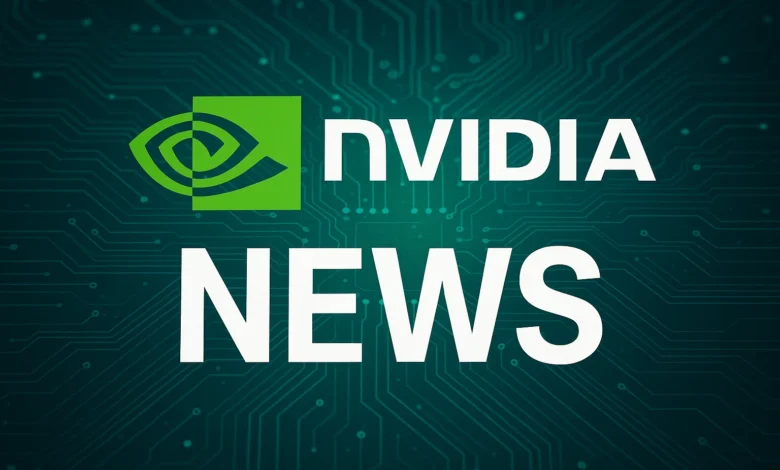
The latest NVIDIA news continues to dominate technology headlines as the company solidifies its position as the undisputed leader in artificial intelligence hardware. With groundbreaking developments in chip manufacturing, strategic global partnerships, and record-breaking financial performance, NVIDIA is reshaping the future of computing.
NVIDIA reported remarkable revenue of $130.5 billion for fiscal 2025, representing a stunning 114% increase year-over-year. This explosive growth reflects the insatiable global demand for AI infrastructure as companies worldwide rush to deploy advanced machine learning capabilities.
Understanding the most recent NVIDIA news is crucial for investors, tech enthusiasts, and business leaders alike. From the revolutionary Blackwell architecture to unprecedented manufacturing partnerships, NVIDIA’s latest moves are setting the stage for the next decade of technological innovation.
NVIDIA Blackwell: The Most Important Chip of Our Generation
Historic US Manufacturing Milestone
In a development that marks a turning point for American semiconductor independence, NVIDIA celebrated the production of its first Blackwell wafer manufactured in the United States at TSMC’s Phoenix, Arizona facility. This achievement represents more than just a manufacturing win—it’s a strategic realignment of the global AI supply chain.
NVIDIA CEO Jensen Huang described this as “the very first time in recent American history that the single most important chip is being manufactured here in the United States by the most advanced fab”. The move strengthens national security, creates high-tech jobs, and reduces dependence on overseas manufacturing for critical AI infrastructure.
Blackwell’s Revolutionary Architecture
The Blackwell architecture represents a quantum leap in AI computing power. Demand for Blackwell has been described as “amazing,” with CEO Jensen Huang noting that reasoning AI adds another scaling law where increasing compute for training makes models smarter.
Key features of Blackwell include:
- Unprecedented Performance: Up to 30x performance improvement for large language model inference compared to previous generations
- Advanced Manufacturing: Built on TSMC’s custom 4NP process node with 104 billion transistors
- Energy Efficiency: Superior power efficiency crucial for massive AI data centers
- Second-Generation Transformer Engine: Support for MXFP4 and MXFP6 data formats enabling faster AI model training
The Blackwell Ultra (B300 series) is scheduled for release in the second half of 2025, promising enhanced compute performance and a significant boost to 288GB of HBM3E memory.
Production Scale and Manufacturing Strategy
NVIDIA’s manufacturing ambitions are nothing short of extraordinary. Within the next four years, NVIDIA plans to produce up to half a trillion dollars of AI infrastructure in the United States through partnerships with TSMC, Foxconn, Wistron, Amkor and SPIL.
The company is establishing comprehensive manufacturing operations:
- TSMC Arizona: Advanced chip fabrication including 2nm, 3nm, 4nm, and A16 technologies
- Houston with Foxconn: Supercomputer assembly and manufacturing
- Dallas with Wistron: Additional supercomputer production facilities
- Arizona with Amkor and SPIL: Packaging and testing operations
Global Partnerships Driving AI Adoption
South Korea: A Quarter-Million GPU Deployment
In one of the most significant AI infrastructure announcements of 2025, NVIDIA made a sweeping agreement with the South Korean government to deploy more than 260,000 of its latest AI chips across the country, including partnerships with Samsung Electronics, SK Group, Hyundai Motor Group and Naver.
This massive deployment will enable:
- Samsung to accelerate semiconductor research and digital transformation
- Hyundai to advance integrated AI model training for manufacturing and autonomous driving
- SK Group to build AI cloud infrastructure for robotics and industrial applications
- Naver to develop Korean large language models with 60,000 NVIDIA chips
The deal could create approximately $750 million in new revenue opportunities for Samsung Electronics and SK Hynix, as each Blackwell GPU incorporates 192GB of HBM3E memory.
Germany’s Industrial AI Revolution
Deutsche Telekom and NVIDIA unveiled the world’s first Industrial AI Cloud, a sovereign, enterprise-grade platform set to go live in early 2026. This partnership brings together trusted infrastructure and NVIDIA’s cutting-edge AI technology to transform German manufacturing and industry.
Financial Performance: Breaking Records Quarter After Quarter
Fiscal 2025 Year-End Results
For the fourth quarter ended January 26, 2025, NVIDIA reported revenue of $39.3 billion, up 12% from the previous quarter and up 78% from a year ago. The company’s earnings per share also showed remarkable growth, demonstrating not just revenue expansion but profitable operations.
Looking Ahead: Q1 Fiscal 2026 Guidance
NVIDIA’s outlook for the first quarter of fiscal 2026 projects revenue of $43.0 billion, plus or minus 2%, with GAAP and non-GAAP gross margins expected to be 70.6% and 71.0%, respectively.
Upcoming Earnings Report
Investors are eagerly awaiting NVIDIA’s fiscal 2026 third-quarter earnings report scheduled for November 19, 2025, which will provide insights into Blackwell adoption rates and continued AI infrastructure demand.
Stock Performance and Market Valuation
Unprecedented Growth Trajectory
NVIDIA stock has surged 1,230% over the past three years, becoming the first stock to reach $5 trillion in value. This astronomical growth reflects both the company’s execution excellence and the transformative impact of AI across industries.
Future Price Predictions
Market analysts remain bullish on NVIDIA’s prospects. CEO Jensen Huang predicts that global data center capital expenditures will reach $3 trillion to $4 trillion by 2030, with NVIDIA positioned to receive a massive chunk of that investment.
If these projections materialize, NVIDIA could produce annual revenues of $1 trillion, potentially valuing the company at $616 per share and making it a $10 trillion company.
China Export Controversy: Navigating Geopolitical Tensions
The Blackwell Export Debate
Recent NVIDIA news has been dominated by discussions about chip exports to China. NVIDIA CEO Jensen Huang stated that his company is effectively blocked from selling its AI chips into China, as Washington and Beijing each impose restrictions.
The situation is complex:
- The US government has approved limited exports of NVIDIA’s less powerful H20 chip
- There are discussions about a potential downgraded Blackwell variant (B30A) for the Chinese market
- A 30-50% downgraded Blackwell could provide China with roughly 12 to 17 times the computing power of the currently approved H20 chip
Strategic Implications
These export restrictions represent a delicate balance between commercial interests and national security concerns. The outcome will significantly impact NVIDIA’s addressable market and China’s AI development capabilities.
Gaming and Consumer Products: DLSS 4 and RTX 50 Series
DLSS 4 Expansion
Beyond data center products, NVIDIA continues innovating in gaming technology. At Gamescom 2025, NVIDIA announced that over 175 released games and apps now support DLSS 4 with Multi Frame Generation, enabling GeForce RTX 50 Series gamers to multiply frame rates.
Highly anticipated titles adding DLSS 4 support include:
- Resident Evil Requiem
- PRAGMATA
- Borderlands 4 (now bundled with select GeForce RTX 50 Series GPUs)
GeForce RTX Technology Leadership
The consumer GPU market remains a significant revenue stream for NVIDIA, with the RTX 50 Series delivering cutting-edge ray tracing, AI-enhanced graphics, and unprecedented gaming performance.
Physical AI and Robotics: The Next Frontier
Newton Physics Engine
NVIDIA is collaborating with Disney Research and Google DeepMind to develop Newton, a physics engine to simulate robotic movements in real-world settings. Disney will be among the first companies to use Newton for next-generation entertainment robots, including Star Wars-inspired BDX droids.
Industrial Applications
Physical AI models powering robots, autonomous vehicles and other intelligent machines must be safe, generalized for dynamic scenarios and capable of perceiving, reasoning and operating in real time. NVIDIA’s platforms are enabling breakthroughs across:
- Autonomous driving systems
- Manufacturing automation
- Warehouse robotics
- Healthcare applications
Market Dominance: Why NVIDIA Leads the AI Revolution
Technological Superiority
NVIDIA’s dominance stems from years of strategic investment in:
- Specialized Hardware: GPUs optimized specifically for parallel processing required by AI workloads
- Software Ecosystem: CUDA programming framework creating a moat against competitors
- Complete Solutions: Integrated hardware-software stacks reducing complexity for customers
- Innovation Velocity: Annual release cadence keeping competitors perpetually behind
Customer Loyalty and Lock-In
Major hyperscalers including Microsoft, Google, Amazon, and Meta have built their entire AI infrastructure around NVIDIA GPUs. Switching costs are prohibitively high, creating sustainable competitive advantages.
The AI Infrastructure Boom
Capital expenditures for AI in 2025 are expected to total $600 billion, representing massive growth opportunity. NVIDIA is positioned to capture a significant share of this spending as the essential provider of AI compute infrastructure.
Competitive Landscape: Challenges on the Horizon
Emerging Competitors
While NVIDIA maintains commanding market share, competition is intensifying:
- AMD: Developing MI series accelerators targeting data center AI workloads
- Intel: Investing heavily in Gaudi AI accelerators
- Qualcomm: Recently announced AI200 and AI250 chips, signaling a strategic challenge to NVIDIA’s dominance by focusing on power-efficient, cost-effective rack-scale AI inference
- Custom Silicon: Tech giants developing proprietary AI chips (Google’s TPU, Amazon’s Trainium)
Maintaining the Lead
NVIDIA’s strategy to maintain leadership includes:
- Accelerated innovation cycles with annual releases
- Vertical integration across hardware, software, and services
- Strategic partnerships locking in major customers
- First-mover advantages in emerging applications like physical AI
Sustainability and Power Efficiency
The Energy Challenge
As AI infrastructure scales globally, power consumption becomes a critical concern. Data centers powered by NVIDIA chips consume enormous amounts of electricity, raising environmental and cost questions.
NVIDIA’s Response
The company is addressing these challenges through:
- Improved Efficiency: Each generation of GPUs delivers more compute per watt
- Liquid Cooling: Advanced thermal management reducing overall energy requirements
- Grid Optimization: NVIDIA is partnering with EPRI, a power industry R&D organization, to use AI to solve problems facing the electrical grid, largely caused by rising power demand from AI itself
Future Roadmap: What’s Next for NVIDIA
Blackwell Ultra and Beyond
NVIDIA has committed to an annual release cadence for its data center platforms, with major new architectures every two years and “Ultra” updates in between. This aggressive schedule ensures continuous technological advancement.
Next-Generation Rubin Architecture
Following Blackwell, NVIDIA’s roadmap includes the Rubin chip architecture, expected to deliver further performance improvements and new capabilities for emerging AI applications.
Expanding Total Addressable Market
NVIDIA is systematically expanding beyond traditional GPU markets into:
- Automotive and autonomous vehicles
- Industrial automation and robotics
- Healthcare and life sciences
- Telecommunications infrastructure
- Scientific computing and research
Investment Considerations: Is NVIDIA Stock a Buy?
Bull Case
Reasons to be optimistic about NVIDIA:
- Dominant market position with limited viable alternatives
- Massive TAM expansion as AI adoption accelerates globally
- Strong execution track record and continuous innovation
- High gross margins demonstrating pricing power
- Strategic partnerships with every major technology company
Bear Case
Potential concerns for investors:
- Valuation multiples reflecting high growth expectations
- Increasing competition from well-funded rivals
- Geopolitical risks affecting China revenue potential
- Cyclical nature of semiconductor industry
- Customer concentration risk with hyperscalers
Long-Term Outlook
Wall Street analysts expect NVIDIA to produce $207 billion in revenue during fiscal 2026. If the company captures approximately one-third of projected AI infrastructure spending through 2030, it could become one of the world’s most valuable companies.
Conclusion
The latest NVIDIA news demonstrates a company at the absolute peak of its capabilities, executing flawlessly across product development, manufacturing, partnerships, and market expansion. From historic US-based Blackwell production to massive international deployments, NVIDIA is building the infrastructure that will power the AI revolution.
CEO Jensen Huang’s vision that “the age of AI is in full steam, propelling a global shift to NVIDIA computing” is materializing before our eyes. Every major technology company, government, and enterprise is racing to deploy AI capabilities, and NVIDIA provides the essential hardware making this transformation possible.
As we look toward 2030, the question isn’t whether AI will transform society—it’s how quickly and completely this transformation will occur. NVIDIA has positioned itself as the indispensable enabler of this future, with technology leadership, manufacturing capacity, and strategic partnerships that competitors will struggle to match.
For investors, technologists, and business leaders, staying informed about NVIDIA news isn’t just about following one company—it’s about understanding the trajectory of the entire technology industry. The decisions NVIDIA makes today will shape the AI-powered world of tomorrow.
Whether you’re considering NVIDIA stock, planning enterprise AI deployments, or simply fascinated by cutting-edge technology, one thing is clear: NVIDIA news will continue dominating headlines as artificial intelligence reshapes every aspect of modern life.
Read More: What is GateToken? Gate.io Future of Secure Blockchain







